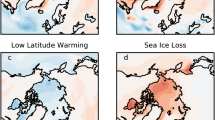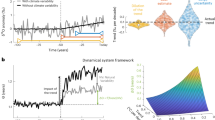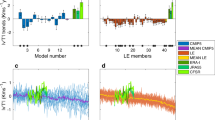Abstract
The surface temperature response to greenhouse gas forcing displays a characteristic pattern of polar-amplified warming1,2,3,4,5, particularly in the Northern Hemisphere. However, the causes of this polar amplification are still debated. Some studies highlight the importance of surface-albedo feedback6,7,8, while others find larger contributions from longwave feedbacks4,9,10, with changes in atmospheric and oceanic heat transport also thought to play a role11,12,13,14,15,16. Here, we determine the causes of polar amplification using climate model simulations in which CO2 forcing is prescribed in distinct geographical regions, with the linear sum of climate responses to regional forcings replicating the response to global forcing. The degree of polar amplification depends strongly on the location of CO2 forcing. In particular, polar amplification is found to be dominated by forcing in the polar regions, specifically through positive local lapse-rate feedback, with ice-albedo and Planck feedbacks playing subsidiary roles. Extra-polar forcing is further shown to be conducive to polar warming, but given that it induces a largely uniform warming pattern through enhanced poleward heat transport, it contributes little to polar amplification. Therefore, understanding polar amplification requires primarily a better insight into local forcing and feedbacks rather than extra-polar processes.
This is a preview of subscription content, access via your institution
Access options
Access Nature and 54 other Nature Portfolio journals
Get Nature+, our best-value online-access subscription
$29.99 / 30 days
cancel any time
Subscribe to this journal
Receive 12 print issues and online access
$209.00 per year
only $17.42 per issue
Buy this article
- Purchase on Springer Link
- Instant access to full article PDF
Prices may be subject to local taxes which are calculated during checkout




Similar content being viewed by others
Data availability
The model source code to reproduce these experiments can be obtained from http://www.cesm.ucar.edu/models/cesm1.2/ and the modifications to prescribe spatially varying CO2 concentrations can be obtained from the corresponding author.
References
Manabe, S. & Wetherald, R. The effects of doubling the CO2 concentrations on the climate of a general circulation model. J. Atmos. Sci. 32, 3–15 (1975).
Holland, M. M. & Bitz, C. M. Polar amplification of climate change in coupled models. Clim. Dynam. 21, 221–232 (2003).
Bintanja, R., Graversen, R. G. & Hazeleger, W. Arctic winter warming amplified by the thermal inversion and consequent low infrared cooling to space. Nat. Geosci. 4, 758–761 (2011).
Pithan, F. & Mauritsen, T. Arctic amplification dominated by temperature feedbacks in contemporary climate models. Nat. Geosci. 7, 181–184 (2014).
Park, K., Kang, S. M., Kim, D., Stuecker, M. F. & Jin, F.-F. Contrasting local and remote impacts of surface heating on polar warming and amplification. J. Clim. 31, 3155–3166 (2018).
Screen, J. A. & Simmonds, I. The central role of diminishing sea ice in recent Arctic temperature amplification. Nature 464, 1334–1337 (2010).
Screen, J. A., Deser, C. & Simmonds, I. Local and remote controls on observed Arctic warming. Geophys. Res. Lett. 39, L10709 (2012).
Taylor, P. C. et al. A decomposition of feedback contributions to polar warming amplification. J. Clim. 26, 7023–7043 (2013).
Winton, M. Amplified Arctic climate change: what does surface albedo feedback have to do with it? Geophys. Res. Lett. 33, L03701 (2006).
Goosse, H. et al. Quantifying climate feedbacks in polar regions. Nat. Commun. 9, 1919 (2018).
Graversen, R. G., Mauritsen, T., Tjernström, M., Källén, E. & Svensson, G. Vertical structure of recent Arctic warming. Nature 451, 53–56 (2008).
Lu, J. & Cai, M. Quantifying contributions to polar warming amplification in an idealized coupled general circulation model. Clim. Dynam. 34, 669–687 (2010).
Lee, S., Gong, T., Johnson, N., Feldstein, S. B. & Pollard, D. On the possible link between tropical convection and the Northern Hemisphere Arctic surface air temperature change between 1958 and 2001. J. Clim. 24, 4350–4367 (2011).
Spielhagen, R. F. et al. Enhanced modern heat transfer to the Arctic by warm Atlantic water. Science 331, 450–453 (2011).
Hwang, Y.-T., Frierson, D. M. W. & Kay, J. E. Coupling between Arctic feedbacks and changes in poleward energy transport. Geophys. Res. Lett. 38, L17704 (2011).
Huang, Y., Xia, Y. & Tan, X. On the pattern of CO2 radiative forcing and poleward energy transport. J. Geophys. Res. Atmos. 122, 10578–10593 (2017).
Shindell, D. & Faluvegi, G. Climate response to regional radiative forcing during the twentieth century. Nat. Geosci. 2, 294–300 (2009).
Kang, S. M., Park, K., Jin, F.-F. & Stuecker, M. F. Common warming pattern emerges irrespective of forcing location. J. Adv. Model Earth Syst. 9, 2413–2424 (2017).
Woods, C. & Caballero, R. The role of moist intrusions in winter Arctic warming and sea ice decline. J. Clim. 29, 4473–4485 (2016).
Alexeev, V. A., Langen, P. L. & Bates, J. R. Polar amplification of surface warming on an aquaplanet in ‘ghost forcing’ experiments without sea ice feedbacks. Clim. Dynam. 24, 655–666 (2005).
Chung, C. E. & Räisänen, P. Origin of the Arctic warming in climate models. Geophys. Res. Lett. 38, L21704 (2011).
Rose, B. E. J., Armour, K. C., Battisti, D. S., Feldl, N. & Koll, D. D. B. The dependence of transient climate sensitivity and radiative feedbacks on the spatial pattern of ocean heat uptake. Geophys. Res. Lett. 41, 1071–1078 (2014).
Bitz, C. M., Gent, P. R., Woodgate, R. A., Holland, M. M. & Lindsay, R. The influence of sea ice on ocean heat uptake in response to increasing CO2. J. Clim. 19, 2437–2450 (2006).
Marshall, J. et al. The ocean’s role in the transient response of climate to abrupt greenhouse gas forcing. Clim. Dynam. 44, 2287–2299 (2015).
Armour, K. C., Marshall, J., Scott, J., Donohoe, A. & Newsom, E. R. Southern Ocean warming delayed by circumpolar upwelling and equatorward transport. Nat. Geosci. 9, 549–554 (2016).
Roe, G. H., Feldl, N., Armour, K. C., Hwang, Y.-T. & Frierson, D. M. W. The remote impacts of climate feedbacks on regional climate predictability. Nat. Geosci. 8, 135–139 (2015).
Shell, K. M., Kiehl, J. T. & Shields, C. A. Using the radiative kernel technique to calculate climate feedbacks in NCAR’s community atmospheric model. J. Clim. 21, 2269–2282 (2008).
Bitz, C. M. et al. Climate sensitivity of the community climate system model, version 4. J. Clim. 25, 3053–3070 (2012).
Lee, S., Gong, T., Feldstein, S. B., Screen, J. A. & Simmonds, I. Revisiting the cause of the 1989–2009 Arctic surface warming using the surface energy budget: downward infrared radiation dominates the surface fluxes. Geophys. Res. Lett. 44, 10654–10661 (2017).
Cronin, T. W. & Jansen, M. F. Analytic radiative-advective equilibrium as a model for high-latitude climate. Geophys. Res. Lett. 43, 449–457 (2015).
Gent, P. R. et al. The community climate system model version 4. J. Clim. 24, 4973–4991 (2011).
Neale, R. B. et al. The mean climate of the community atmosphere model (CAM4) in forced SST and fully coupled experiments. J. Clim. 26, 5150–5168 (2013).
Kang, S. M., Held, I. M., Frierson, D. M. W. & Zhao, M. The response of the ITCZ to extratropical thermal forcing: idealized slab-ocean experiments with a GCM. J. Climate 21, 3521–3532 (2008).
Santer, B. D., Wigley, T. M. L., Schlesinger, M. E. & Mitchell, J. F. B. Developing Climate Scenarios from Equilibrium GCM Results Technical Report 47 (Max-Planck-Institut-für-Meteorologie, 1990).
Tebaldi, C. & Arblaster, J. M. Pattern scaling: its strengths and limitations, and an update on the latest model simulations. Climatic Change 122, 459–471 (2014).
Hansen, J. et al. Efficacy of climate forcings. J. Geophys. Res. 110, D18104 (2005).
Pincus, R., Forster, P. M. & Stevens, B. The Radiative Forcing Model Intercomparison Project (RFMIP): experimental protocol for CMIP6. Geosci. Model Dev. 9, 3447–3460 (2016).
Good, P. et al. Nonlinear regional warming with increasing CO2 concentrations. Nat. Clim. Change 5, 138–142 (2015).
Armour, K. C., Bitz, C. M. & Roe, G. H. Time-varying climate sensitivity from regional feedbacks. J. Clim. 26, 4518–4534 (2013).
Acknowledgements
M.F.S. was supported by the Institute for Basic Science (project code IBS-R028-D1) and NOAA Climate and Global Change Postdoctoral Fellowship Program, administered by UCAR’s Cooperative Programs for the Advancement of Earth System Sciences. C.M.B. was supported by NOAA grant CPO NA115OAR4310161. C.P. was supported by a JISAO postdoctoral fellowship. K.C.A. and Y.D. were supported by NSF grants AGS-1752796 and OCE-1523641. S.M.K. and D.K. were supported by the Basic Science Research Program through the National Research Foundation of Korea, funded by the Ministry of Science, ICT and Future Planning (2016R1A1A3A04005520). S.M. was supported by the Australian Research Council (grant numbers FT160100162 and CE170100023). F.-F.J. was supported by NSF grant AGS-1813611 and Department of Energy grant DE-SC0005110. Computing resources were provided by the University of Southern California’s Center for High-Performance Computing.
Author information
Authors and Affiliations
Contributions
M.F.S. designed the study, conducted the model experiments and wrote the initial manuscript draft. M.F.S., C.M.B. and D.K. performed the analysis. All authors contributed to the interpretation of the results and improvement of the manuscript.
Corresponding author
Ethics declarations
Competing interests
The authors declare no competing interests.
Additional information
Publisher’s note: Springer Nature remains neutral with regard to jurisdictional claims in published maps and institutional affiliations.
Supplementary information
Supplementary Information
Supplementary figures 1–6
Rights and permissions
About this article
Cite this article
Stuecker, M.F., Bitz, C.M., Armour, K.C. et al. Polar amplification dominated by local forcing and feedbacks. Nature Clim Change 8, 1076–1081 (2018). https://doi.org/10.1038/s41558-018-0339-y
Received:
Accepted:
Published:
Issue Date:
DOI: https://doi.org/10.1038/s41558-018-0339-y
This article is cited by
-
The role of interdecadal climate oscillations in driving Arctic atmospheric river trends
Nature Communications (2024)
-
Emergent climate change patterns originating from deep ocean warming in climate mitigation scenarios
Nature Climate Change (2024)
-
Rising geopotential height under global warming
Climate Dynamics (2024)
-
Decoupling of Arctic variability from the North Pacific in a warmer climate
npj Climate and Atmospheric Science (2023)
-
Arctic warming contributes to increase in Northeast Pacific marine heatwave days over the past decades
Communications Earth & Environment (2023)



